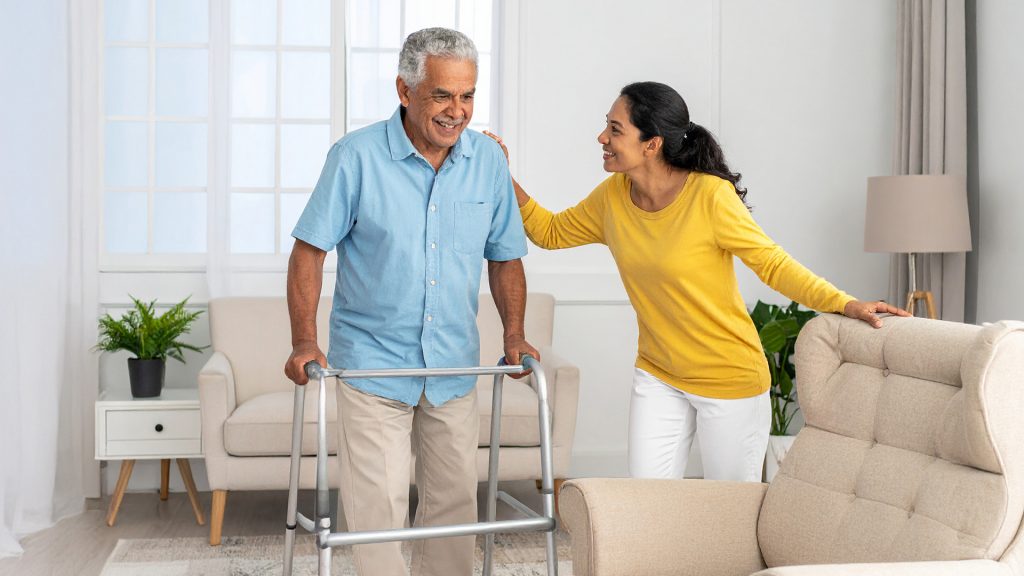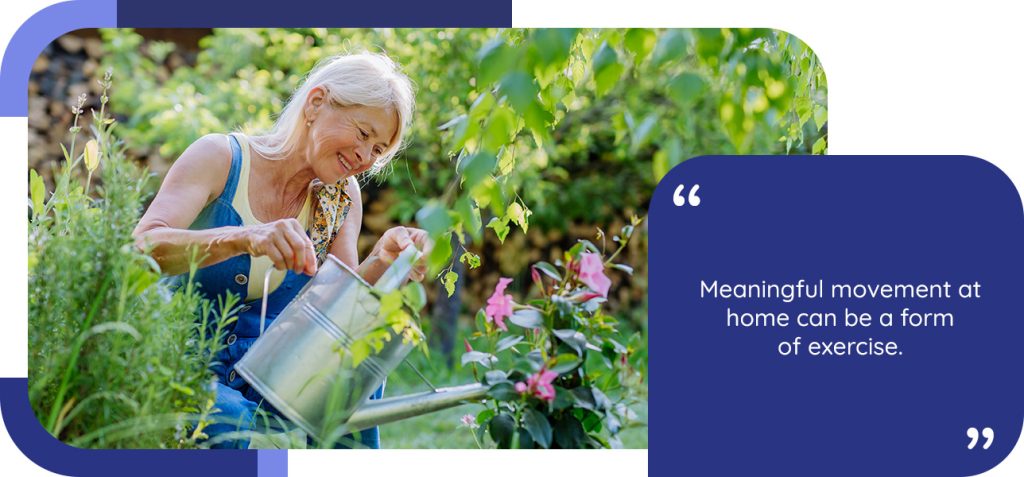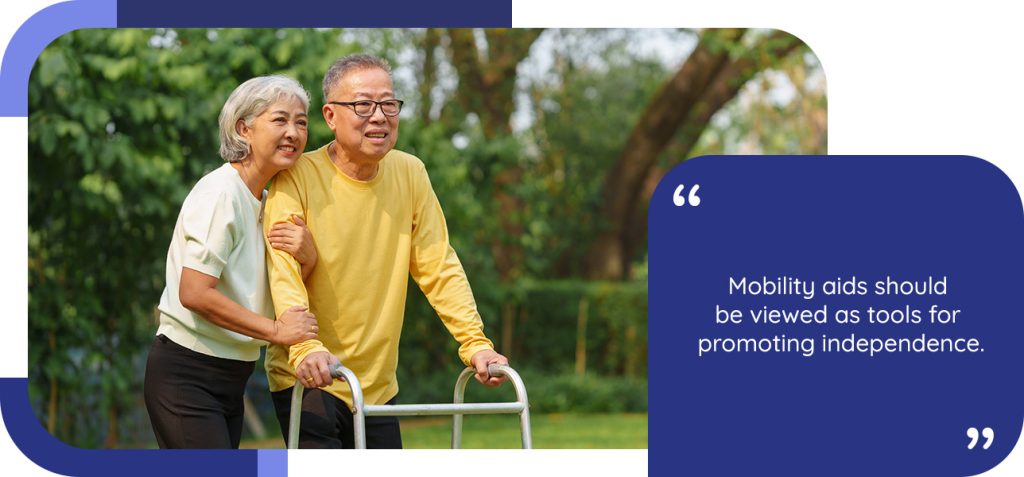How to help your loved one with reduced mobility

Watching someone you care about struggle with everyday movements can feel overwhelming. Perhaps your parent finds it harder to get out of their chair, or your partner needs help with tasks they once managed easily. You want to help, but knowing where to start and how to provide support without taking away their independence requires both knowledge and sensitivity.
Reduced mobility affects millions of families across Britain. Whether caused by ageing, illness, injury, or chronic conditions, movement difficulties change daily life for everyone involved. The good news is that with the right approach, adaptive equipment, and practical strategies, you can make a real difference to your loved one’s comfort, safety, and quality of life.
This guide provides practical, compassionate advice for supporting someone with mobility challenges. You’ll discover simple movement strategies, learn about helpful equipment and home modifications, and understand how to encourage independence while ensuring safety. Most importantly, you’ll find ways to help that preserve dignity and strengthen your relationship rather than strain it.
Table of contents
1. Understanding what reduced mobility really means
2. The wider effects of limited movement
3. Creating opportunities for daily movement
4. Building flexibility safely
5. Maintaining strength without strain
6. Making your home safer and more accessible
7. The transformative power of adjustable furniture
8. Supporting progress with realistic goals
9. Caring for yourself while caring for others
10. Resources for continued support
11. Transform mobility challenges into comfort with Adjustamatic
1. Understanding what reduced mobility really means
Before you can help effectively, it’s important to understand what your loved one faces each day. Reduced mobility isn’t simply about walking less; it affects every aspect of daily life in ways that may not be immediately obvious.
Common causes and their impact
Movement difficulties arise from many sources. Natural ageing causes muscle loss – about one percent annually from our mid-fifties onwards. Chronic conditions like arthritis create joint pain that makes movement uncomfortable. Diabetes can affect circulation and nerve function in the feet and legs. Heart and lung conditions reduce stamina and make even short walks exhausting.
Neurological conditions present particular challenges. Someone recovering from a stroke could have weakness on one side of their body. Parkinson’s disease affects balance and coordination. Multiple sclerosis can cause unpredictable changes in strength and stability from day to day.
Recent surgery or injuries create temporary but significant mobility issues. Hip replacements, knee operations, or broken bones all require careful recovery periods where movement must be balanced with healing. Even something as simple as poor eyesight can affect mobility when someone can’t clearly see obstacles or judge distances.
Understanding the specific cause helps you provide appropriate support. Joint pain might improve with warmth and gentle movement, while post-surgery recovery requires gradually increasing activity within safe limits. Always encourage your loved one to discuss mobility changes with their doctor, as some causes are treatable or manageable with the right medical support.
2. The wider effects of limited movement
When someone moves less, the consequences ripple through their entire wellbeing. Physically, muscles weaken further from lack of use. Joints become stiffer. Blood circulation slows, leading to swollen ankles and feet. Sitting or lying in one position too long can cause pressure sores. Weight gain becomes more likely when activity decreases but eating habits remain unchanged.
These physical changes affect mental health too. Losing independence can trigger frustration, anxiety, and depression. Social isolation often follows when getting out becomes difficult. Self-esteem suffers when someone can’t manage tasks they’ve done for decades. Sleep problems develop when the body isn’t tired from activity.
Yet even small improvements in movement can reverse many of these effects. Simply standing up regularly can improve circulation and maintain muscle strength. Gentle stretches preserve flexibility. Short walks, even just around the house, boost mood and energy. Your role is to encourage and enable these movements in ways that feel achievable rather than overwhelming.
3. Creating opportunities for daily movement
The secret to maintaining mobility lies not in intense exercise sessions but in frequent, gentle movement throughout the day. Think of it as sprinkling activity into normal routines rather than scheduling formal exercise.
Movement throughout the day
Encourage your loved one to move at least once every hour during waking hours. This doesn’t mean lengthy walks or strenuous activity. Simple actions count: standing up to look out the window, walking to the kitchen for a glass of water, or doing a few gentle stretches while the kettle boils.
Make movement purposeful rather than abstract. Instead of suggesting “exercises,” incorporate activity into meaningful tasks. Watering plants, sorting post while standing, or walking to answer the door all provide movement with purpose. People are more likely to maintain activities that feel useful rather than prescribed.
If standing is difficult, seated movement still provides benefits. Foot pedal exercisers fit under chairs and allow leg movement while watching television or reading. Arm movements, seated marches, or gentle twists keep joints mobile without requiring standing. Even flexing ankles and wiggling toes improves circulation.

4. Building flexibility safely
Regular stretching maintains range of motion in joints and reduces discomfort. Focus on gentle movements that feel good rather than pushing through pain.
Ankles benefit from gentle circles and flexing movements. These improve circulation and reduce swelling while maintaining flexibility needed for walking. Encourage your loved one to “write” the alphabet with their toes while seated.
Knees need careful attention, especially if arthritis is present. Seated knee lifts, where one knee rises toward the chest then lowers slowly, maintain hip flexibility while strengthening supporting muscles. Never force the movement – even small lifts help.
Shoulders and neck often hold tension, particularly when mobility issues create stress. Gentle shoulder rolls, careful head turns, and reaching movements prevent stiffness. These can be done seated or standing with support.
Back flexibility matters for everything from reaching to walking. Seated twists, where the upper body turns gently while hips stay forward, maintain spinal mobility. Cat-cow stretches can be modified for seated positions.
Each stretch should feel like a gentle pull, never sharp pain. Hold positions for five to ten seconds, breathing normally. Repeat movements two or three times rather than holding for long periods. Morning stretches help ease overnight stiffness, while evening stretches promote relaxation.
5. Maintaining strength without strain
Preserving muscle strength doesn’t require gym equipment or intense workouts. Simple resistance exercises using body weight or everyday items work effectively.
-
Chair exercises provide excellent strength building with built-in safety. Sitting down and standing up slowly strengthens legs and core muscles. Start with hands on chair arms for support, progressing to hands crossed over chest as strength improves. Even five repetitions make a difference when done regularly.
-
Wall push-ups work upper body muscles safely. Standing arm’s length from a wall, place palms flat against it at shoulder height. Lean forward slowly then push back. This builds arm and chest strength without floor exercises.
-
Resistance bands offer versatile strength training. These stretchy bands come in different strengths and can be used seated or standing. Simple pulling or pushing movements work various muscle groups. Many find bands less intimidating than weights.
-
Water bottles or tin cans serve as light weights for arm exercises. Lifting these everyday items while seated builds upper body strength. Start with lighter items, increasing weight gradually as strength improves.
-
Walking itself builds strength when done regularly. Even short distances count. Walking to the letterbox, around the garden, or just across the room several times maintains leg strength and cardiovascular fitness.
6. Making your home safer and more accessible
Your home environment significantly impacts mobility and independence. Simple modifications can transform challenging spaces into supportive ones that encourage movement rather than restrict it.
Essential safety modifications
Start with the basics: clear pathways throughout your home. Remove loose rugs that could cause trips. Secure electrical cords along walls. Ensure adequate lighting, especially in hallways, stairs, and bathrooms. Motion-sensor lights help during nighttime bathroom visits.
Install grab rails where they’re needed most. Bathrooms particularly benefit from rails beside toilets and in showers or baths. Stairways need sturdy handrails on both sides if possible. Consider rails in bedrooms beside the bed or along walls in main walkways.
Non-slip surfaces prevent dangerous falls. Apply non-slip strips to stairs and bathroom floors. Use non-slip mats in showers and baths. Even non-slip socks provide extra grip on smooth floors, though proper footwear is always preferable.
Furniture adjustments for easier movement
Furniture height makes a tremendous difference to mobility. Chairs and sofas should allow feet to rest flat on the floor with knees at roughly ninety degrees when seated. Too low, and standing becomes difficult. Too high, and stability suffers.
Consider chair raisers or furniture blocks to achieve optimal height. These simple devices lift existing furniture safely. Alternatively, firm cushions can raise seating height, though ensure they don’t slide.
Bed height also matters. Your loved one should be able to sit on the bed edge with feet flat on the floor. From this position, standing becomes easier. Bed raisers can adjust height if needed. Position the bed to allow access from both sides if possible, providing more options for getting in and out.
Keep frequently used items within easy reach. Reorganise kitchen cupboards so everyday dishes and food are at accessible heights. Place television remotes, phones, and reading materials on stable side tables. A bedside organiser keeps necessities close without requiring stretching or bending.
Mobility aids that promote independence
Many people resist mobility aids, viewing them as signs of decline. Reframe them as tools for promoting independence. A walking stick or frame enables continued outings. A perching stool in the kitchen allows meal preparation without standing throughout.
Walking aids come in many forms. Single-point sticks provide light support and confidence. Four-wheeled walkers offer stability with seats for resting. Rollators include brakes and shopping baskets. The right aid depends on individual needs and should be properly fitted by a professional.
Bathroom aids significantly improve safety and confidence. Raised toilet seats reduce the distance needed to sit and stand. Shower seats allow washing without standing throughout. Long-handled sponges eliminate dangerous reaching and bending.
Kitchen aids maintain independence with meal preparation. Perching stools provide support while cooking. Kettle tippers pour safely without lifting. Jar openers compensate for reduced grip strength. Non-slip mats keep plates steady during eating.
Dressing aids preserve dignity and independence. Long-handled shoe horns, sock aids, and button hooks allow self-dressing despite limited flexibility. Elastic shoelaces convert tie shoes to slip-ons.
7. The transformative power of adjustable furniture
Specialised furniture can dramatically improve quality of life for someone with reduced mobility. While the initial investment might seem significant, the benefits to independence, comfort, and safety often prove invaluable.
Adjustable beds: comfort and independence combined
An adjustable bed revolutionises both sleep and daily comfort for those with mobility issues. Using quiet motors controlled by a simple remote, these beds adjust to countless positions that support specific needs.
Getting in and out becomes much easier when the bed can raise to optimal height. The head section lifts to help your loved one sit up without straining. From this seated position, swinging legs over the edge and standing requires less effort and reduces fall risk.
Health benefits extend beyond easier transfers. Elevating legs improves circulation and reduces swelling – particularly helpful for those who spend long periods seated during the day. Raising the upper body slightly can ease breathing difficulties, reduce snoring, and prevent acid reflux. The ability to find and maintain comfortable positions throughout the night can improve sleep quality significantly.
Modern adjustable beds include thoughtful features that enhance independence. The EasyReach system featured in Adjustamatic beds keeps controls within finger’s reach, eliminating stretching or straining.
Some adjustable beds come with optional safety rails, which provide support when repositioning. Others include massage functions that soothe aching muscles and improve circulation. Many beds available from Adjustamatic include our Cyclo-Therapy massage technology. This provides a safe form of vibration therapy that has been proven to reduce pain caused by a range of medical conditions.
The mattress matters too. Specialised mattresses like Adjustamatic’s AirFlow orthopaedic mattress flex with the bed while providing pressure relief. Memory foam or gel layers prevent pressure sores while maintaining comfort in any position. The right combination of bed and mattress can reduce pain, improve sleep, and restore independence.
Riser recliner chairs: daytime support and comfort
A riser recliner chair complements an adjustable bed by providing similar support during waking hours. These chairs gently lift and tilt forward, helping your loved one stand with minimal effort. The reverse motion allows controlled sitting without the dropping sensation that can feel unsafe.
The lifting mechanism takes pressure off knees and hips, making standing less painful for those with joint problems. This increased ease of standing often means your loved one moves more frequently rather than remaining seated to avoid the struggle of getting up.
When seated, an electric reclining chair can offer multiple comfort positions. The backrest reclines for relaxation while the footrest elevates legs to improve circulation. Many people find that spending time with legs elevated during the day reduces nighttime swelling and discomfort.
Additional features enhance the benefits. Heat functions soothe stiff joints. Massage mechanisms improve circulation and reduce muscle tension. Different sizes ensure proper fit, which is crucial for support and comfort. Memory positions allow quick return to favourite settings.
Together, an adjustable bed and riser recliner chair create an environment that actively supports mobility and comfort throughout the day and night. Rather than struggling with standard furniture, your loved one can focus energy on activities that matter.

8. Supporting progress with realistic goals
Helping someone improve or maintain mobility requires patience, understanding, and realistic expectations. Progress might be slow, but every small improvement matters.
Starting small and building gradually
Begin with tiny, achievable goals. Standing for an extra minute, walking to the next lamppost, or doing three more chair stands might seem insignificant, but these small victories build confidence and strength. Celebrate each achievement genuinely – your encouragement matters more than you might realise.
Create a simple routine that feels manageable rather than overwhelming. Perhaps gentle stretches with morning tea, a short walk after lunch, and seated exercises during evening television. Linking movement to existing activities makes it easier to maintain.
Track progress without pressure. A simple diary noting daily activities helps identify patterns. You might discover your loved one has more energy in the afternoon or feels stiffer on cold days. This information helps adjust plans appropriately.
Respecting limits while encouraging progress
Some days will be harder than others. Pain, fatigue, or low mood might limit activity. On these days, scale back without abandoning movement entirely. Even gentle stretches in bed or seated exercises maintain momentum.
Never push through significant pain or exhaustion. Rest is part of recovery and forcing activity can cause setbacks. Learn to recognise the difference between the mild discomfort of unused muscles and genuine warning signs that rest is needed.
Keep activities enjoyable rather than medicinal. Play favourite music during exercises. Combine movement with social activities like gardening together or walking to visit neighbours. Exercise disguised as fun is more likely to continue.
Involving healthcare professionals
Professional guidance ensures safety and maximises progress. A physiotherapist can design exercises specifically for your loved one’s conditions and abilities. They can teach proper techniques and provide progression plans.
Occupational therapists assess home environments and recommend modifications. They can suggest adaptive equipment and teach energy-saving techniques for daily tasks. Their practical approach focuses on maintaining independence.
Regular medical reviews ensure underlying conditions are properly managed. Sometimes mobility problems stem from treatable issues like medication side effects, vitamin deficiencies, or undiagnosed conditions. Don’t assume decline is inevitable with age.
9. Caring for yourself while caring for others
Supporting someone with mobility issues can be physically and emotionally demanding. Your wellbeing matters too – you can’t pour from an empty cup.
Recognising your own needs
Acknowledge that caregiving is challenging. Feeling frustrated, exhausted, or overwhelmed doesn’t make you a bad person. These are normal responses to a difficult situation. Admitting you need help is wisdom, not weakness.
Maintain your own health through regular check-ups, adequate sleep, and proper nutrition. Keep up your own exercise routine, even if it’s just a short daily walk. Your physical health directly impacts your ability to provide care.
Preserve activities that bring you joy. Whether it’s reading, gardening, or meeting friends for coffee, maintaining personal interests prevents resentment and burnout. You’re entitled to a life beyond caregiving.
Finding support and respite
Share responsibilities whenever possible. Family members, friends, or professional carers can provide regular breaks. Even a few hours weekly makes a difference to your energy and mood.
Connect with support organisations. Carers UK, Age UK, and condition-specific charities offer practical advice, emotional support, and sometimes financial assistance. Online forums connect you with others facing similar challenges.
Consider respite care options. Day centres provide social activities for your loved one while giving you time for yourself. Respite care homes offer longer breaks when needed.
Setting boundaries with love
Establish clear boundaries about what you can and cannot do. It’s okay to say no to requests beyond your capacity. Your loved one’s needs are important, but not at the expense of your complete wellbeing.
Encourage independence where possible rather than doing everything yourself. This benefits both of you – your loved one maintains skills and dignity while you avoid unnecessary exhaustion. Finding this balance takes time and honest communication.
Remember that perfect care doesn’t exist. You’ll make mistakes, lose patience, and have days when you feel you’re not doing enough. Forgive yourself. Your consistent presence and effort matter more than perfection.
10. Resources for continued support
You don’t have to navigate mobility challenges alone. Numerous resources provide information, equipment, and emotional support for both you and your loved one.
Professional services offer specialised expertise. NHS physiotherapy services provide exercise programmes and mobility assessments. Occupational therapy services recommend home modifications and adaptive equipment. Social services can arrange care assessments and support packages.
Charitable organisations offer condition-specific support. Versus Arthritis provides exercise guides and pain management advice. Parkinson’s UK offers movement classes and support groups. The MS Society runs exercise programmes tailored for multiple sclerosis. These organisations understand the unique challenges of specific conditions.
Local resources often provide practical help. Community centres run seated exercise classes and social groups. Libraries offer information and sometimes equipment loans. Council services may provide grab rails, ramps, and other modifications. Age UK branches offer various services from befriending to handyperson schemes.
Online resources provide accessible information. NHS websites offer exercise videos and health guidance. Equipment suppliers provide detailed guides about choosing appropriate aids. Support forums connect you with others facing similar situations, offering practical tips and emotional understanding.

11. Transform mobility challenges into comfort with Adjustamatic
Supporting a loved one with reduced mobility requires dedication, patience, and the right equipment. While you provide the care and encouragement, Adjustamatic can supply the specialised furniture that makes daily life easier, safer, and more comfortable for both of you.
Your partner in mobility support
For over sixty years, Adjustamatic has helped British families manage mobility challenges with dignity and independence. We understand that watching someone you love struggle with movement is heartbreaking. Our adjustable beds and riser recliner chairs are designed specifically to restore confidence, reduce pain, and maintain independence for as long as possible.
Every product we create comes from listening to families like yours. We know the frustration of watching someone struggle to get out of bed. We understand the worry when leaving them alone. We recognise the exhaustion of being a full-time carer. Our furniture addresses these challenges practically and compassionately.
Solutions designed for real life
Adjustable beds that truly help
Our beds are engineered to make every aspect of daily life easier. The precise positioning helps your loved one sit up independently, transfer safely to standing, and find comfortable positions that relieve pain and improve sleep.
Riser recliner chairs for daytime independence
Complementing our beds, our chairs provide crucial support during waking hours. The smooth lift mechanism removes the struggle from standing, encouraging more frequent movement. Multiple positions allow comfort whether reading, watching television, or napping.
Pressure-relieving mattresses
Our AirFlow and specialised adjustable mattresses work perfectly with adjustable beds while providing crucial pressure relief. They help prevent sores, improve circulation, and ensure comfort in any position.
Support that extends beyond products
We know that choosing mobility furniture feels overwhelming when you’re already managing so much. Our team specialises in making this process simple and reassuring. We listen to your specific situation, explain options clearly, and recommend only what will genuinely help.
Our free home consultations let your loved one try equipment in familiar surroundings. There’s no pressure, just honest advice about what might improve their daily life. We can assess your space, discuss your concerns, and demonstrate how our furniture works.
If your loved one qualifies for VAT relief due to their condition, we’ll guide you through the process. We offer flexible payment options, including interest-free finance, making quality equipment accessible without financial strain.
Making a lasting difference
When you choose Adjustamatic, you’re investing in your loved one’s independence and your own peace of mind. Our equipment is built to last, with comprehensive warranties and ongoing support. We’ll be here years from now if you need advice, servicing, or additional equipment as needs change.
Many families tell us our furniture transformed their situation. Parents who struggled to get out of bed now manage independently. Partners with arthritis find relief from pain and stiffness. Carers report less physical strain and worry. These improvements ripple through entire families, reducing stress and restoring quality of life.
Take the first step today
You don’t have to manage mobility challenges alone. Let Adjustamatic provide the equipment that makes caring easier and helps your loved one maintain dignity and independence.
Call us free on 0800 689 9823 to discuss your situation with our caring, knowledgeable team. We’ll listen to your concerns, answer your questions, and suggest practical solutions. There’s never any pressure – just honest advice from people who understand what you’re facing.
Request our free information pack to explore options at your own pace. Learn about our full range of adjustable beds, riser recliner chairs, and accessories designed specifically for mobility challenges.
Supporting someone with reduced mobility is one of the most challenging yet important things you’ll ever do. With Adjustamatic’s equipment and support, you can make this journey easier for both of you.


